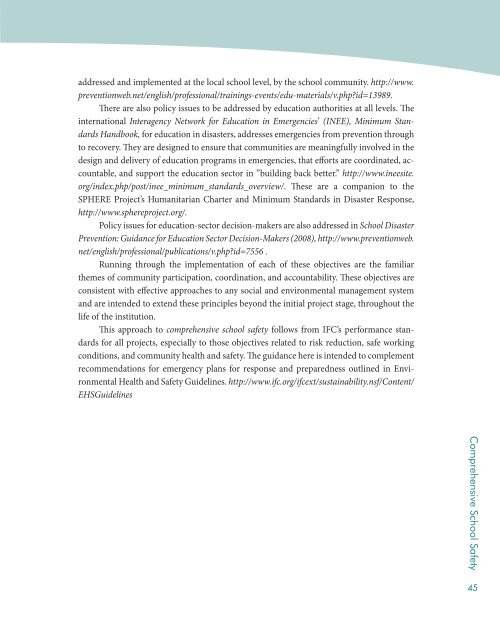Disaster and Emergency Preparedness: Guidance for ... - INEE Toolkit
Disaster and Emergency Preparedness: Guidance for ... - INEE Toolkit
Disaster and Emergency Preparedness: Guidance for ... - INEE Toolkit
Create successful ePaper yourself
Turn your PDF publications into a flip-book with our unique Google optimized e-Paper software.
addressed <strong>and</strong> implemented at the local school level, by the school community. http://www.preventionweb.net/english/professional/trainings-events/edu-materials/v.php?id=13989.There are also policy issues to be addressed by education authorities at all levels. Theinternational Interagency Network <strong>for</strong> Education in Emergencies’ (<strong>INEE</strong>), Minimum St<strong>and</strong>ardsH<strong>and</strong>book, <strong>for</strong> education in disasters, addresses emergencies from prevention throughto recovery. They are designed to ensure that communities are meaningfully involved in thedesign <strong>and</strong> delivery of education programs in emergencies, that ef<strong>for</strong>ts are coordinated, accountable,<strong>and</strong> support the education sector in ”building back better.” http://www.ineesite.org/index.php/post/inee_minimum_st<strong>and</strong>ards_overview/. These are a companion to theSPHERE Project’s Humanitarian Charter <strong>and</strong> Minimum St<strong>and</strong>ards in <strong>Disaster</strong> Response,http://www.sphereproject.org/.Policy issues <strong>for</strong> education-sector decision-makers are also addressed in School <strong>Disaster</strong>Prevention: <strong>Guidance</strong> <strong>for</strong> Education Sector Decision-Makers (2008), http://www.preventionweb.net/english/professional/publications/v.php?id=7556 .Running through the implementation of each of these objectives are the familiarthemes of community participation, coordination, <strong>and</strong> accountability. These objectives areconsistent with effective approaches to any social <strong>and</strong> environmental management system<strong>and</strong> are intended to extend these principles beyond the initial project stage, throughout thelife of the institution.This approach to comprehensive school safety follows from IFC’s per<strong>for</strong>mance st<strong>and</strong>ards<strong>for</strong> all projects, especially to those objectives related to risk reduction, safe workingconditions, <strong>and</strong> community health <strong>and</strong> safety. The guidance here is intended to complementrecommendations <strong>for</strong> emergency plans <strong>for</strong> response <strong>and</strong> preparedness outlined in EnvironmentalHealth <strong>and</strong> Safety Guidelines. http://www.ifc.org/ifcext/sustainability.nsf/Content/EHSGuidelinesComprehensive School Safety45
















